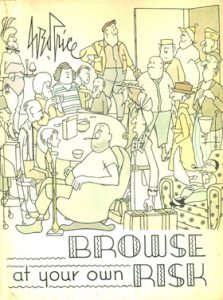George Price: “The Chuckling Champion Of The Washed-Out Man”
We expect puffery in advertising, and this ad for the late great George Price’s 1940 cartoon collection, Good Humor Man, doesn’t disappoint (“the year’s biggest and best book of humor”). I like the “chuckling champion” but “washed-out man” seems a bit, well, odd as a selling point.
Price’s cartoon world was loaded-up with characters (one of his collections is titled, appropriately, Characters). Now that I’ve seen this ad copy, I’m going to fight thinking of his people that way (as washed-out). To me, his people were regular folks getting by.
 I can’t help but think of George Booth’s people when I look at Price’s work. Booth was admittedly influenced by Price, telling Lee Lorenz: “…I examined his work closely…” (the two cartoon gods co-existed at The New Yorker, with Booth coming in during last 22 years of Price’s 62 year run at the magazine). Both excelled at filling up their drawings with personally stamped humorously drawn people and things.
I can’t help but think of George Booth’s people when I look at Price’s work. Booth was admittedly influenced by Price, telling Lee Lorenz: “…I examined his work closely…” (the two cartoon gods co-existed at The New Yorker, with Booth coming in during last 22 years of Price’s 62 year run at the magazine). Both excelled at filling up their drawings with personally stamped humorously drawn people and things.
During my earliest days of studying New Yorker cartoons, I found much to soak up from both George’s work, but I found Booth’s world warmer — more approachable. Price’s drawings were brittle — constructed as if he used mechanical tools. The mechanical element, present in his earliest work, but not dominating, soon developed into his signature; would his “washed-out” people been as interesting to us without it? Hard to know. It’s no secret that Price relied 100% on writers for his cartoons*. I always thought his gift was convincing readers, through the use of diagrammatic lines, that the ideas were born out of his hours at the drawing board.
_____________________________________________________________________________
*A portion of Good Humor Man is given over to a section titled “Sketch Pad and Diary Notes.” The diary notes are meant to be humorous. But in a somewhat bizarre passage Price has this to say:
“The grimmest part of this business is digging up ideas. Many artist[s] employ gagmen. Personally I found this method far less than satisfactory.”
To make this whole enterprise even odder is that Good Humor Man was, according to the copy on the dust jacket “compiled and edited by Richard McCallister.” Mr. McCallister was the king of the gagmen. One of his many clients was George Price.
__________________________________
George Price’s A-Z Entry
George Price (above) Born in Coytesville, New Jersey, June 9, 1901. Died January 12, 1995, Engelwood, New Jersey. New Yorker work: 1929 – 1991. Lee Lorenz, the New Yorker’s former Art/Cartoon editor, called Price one of the magazine’s great stylists (along with Peter Arno, Helen Hokinson, James Thurber, and William Steig. Of the many Price collections, here are two favorites: Browse At Your Own Risk (1977), and The World of George Price: A 55-Year Retrospective (1988)





Howdy, Michael, I agree with your observation: “I found much to soak up from both George’s work, but I found Booth’s world warmer — more approachable. Price’s drawings were brittle — constructed as if he used mechanical tools.” I, too, studied the work of both Price and Booth over the decades and, while I admired Price’s original drawing style, I rarely chuckled at his jokes. George Booth, on the other hand, often made me laugh out loud. Booth created a world that was wonderfully nutty, his ongoing scenes of guys in a garage working on cars and those endless interior scenes with the husband in the bathtub and the wife at the ironing board, talking to each other. And, how about the almost Goldbergian array of extension cords hanging all around the room? Booth was not a gag cartoonist, he created a zany world, filled with crazed dogs and abandoned lawn mowers, but it was a warm, inviting world, one that I loved visiting over and over.
Oops, I meant to honor the other late, great George, Mr. Price and segued over to the Booth booth. As I said, George Price’s drawings were wonderful and I always admired them. Enough to fill a file folder with clipped out his New Yorker cartoons. But he never captured my funny bone like George Booth did. Not even close.
Thanks, Michael, for your wonderful New Yorker cartoonist posts. And a hearty thanks for your own warm, gentle, quirky and always funny New Yorker cartoons.
I see that my indentations in my response above were all discarded. Sorry for the ultra long rambling paragraph. -ES